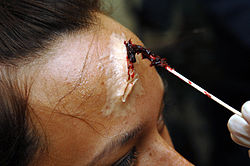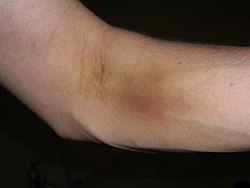Types of wounds
Wounds are normally described in a variety of ways. Descriptions may include wound size (length) and thickness; plainly visible wound characteristics such as shape and open or closed; and origin, acute or chronic. [3] The most common descriptors of wounds are these:
- Incision: Straight edges to the wound margins, as if sliced with a knife. These can vary in size, and may be caused by a variety of objects, including a scalpel, a knife, any piece of straight, sharp metal, or a piece of glass. Tissue is rarely missing from the wound site, and the margins of the wound may be easily matched from one side of the wound to the other for the purposes of closure. [4]
- Laceration: Jagged edges to the wound margins, more closely resembling a tear than a slice. The direction of the wound is random rather than straight, and it may have multiple branches. [5] Most often caused by an object with a broken or serrated edge, such as a piece of broken glass or metal, but may also be caused by a blow from a blunt object to tissue with bone immediately behind it.
- Puncture: Sharp object penetrates the tissue and travels inward, but does not move laterally in any direction from the point of entry. [6] Such wounds can be misleading, as they may appear quite small on surface examination, but extend quite deeply into the body, even damaging nerves, blood vessels, or internal organs. They may cause substantial internal bleeding or secondary injuries, such as a collapsed lung, which may not be readily evident during primary assessment. Occasionally, the object causing the injury remains in the wound as an impaled object. A stab wound from a knife or other sharp object, or a bullet wound, are examples of this type of injury. Medical professionals usually refer to this type of wound as penetrating trauma.
- Abrasion: A scraping or scratching. Generally quite superficial, and affecting only the surface layers of the epidermis. [7] No internal organs, nerves, or blood vessels other than capillaries, are affected. This may be the result of a fall, or of sliding (friction) against rough surfaces. The road rash often suffered by falling motorcyclists is an example of this type of wound.
- Contusion: Simple bruising. In this type of injury, the capillaries in the epidermis and dermis are damaged, without breaking the skin. [8] Blood oozes out of these vessels into the spaces between cells or interstitial space, causing swelling and discoloration. Blood loss is generally limited, and not of serious consequence. It may, however, act as a signpost, pointing to more serious injuries.
- Avulsion: A full thickness laceration-type wound, often semi-circular in shape. This creates a flap that, when lifted, exposes the deeper tissues to view, or extrudes them from the wound itself. [9] Avulsions often occur in mechanical accidents involving fingers (sometimes referred to as degloving), or, more seriously, may affect the orbit of the eye or the abdominal cavity, exposing the internal viscera. Avulsions are difficult to repair, and no avulsion should ever be considered a minor injury.
- Amputation: Similar to, but distinct from, an avulsion. Whereas an avulsion is characterized by a "flap" of skin being removed, an amputation is characterized by a complete loss of a limb. This can occur at any point on the extremity, and is usually followed by significant arterial bleeding. However, as serious as this injury is, an amputated limb that is cooled and transported to the hospital can sometimes be surgically reattached.
- Types of wounds
- Laceration moulage
- Abrasion on the palm of the hand
- Contusion



